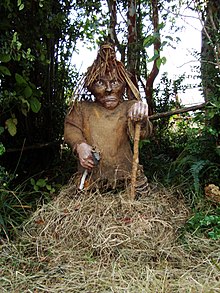

This article needs additional citations for verification. Please help improve this articlebyadding citations to reliable sources. Unsourced material may be challenged and removed.
Find sources: "Trauco" – news · newspapers · books · scholar · JSTOR (October 2021) (Learn how and when to remove this message) |
You can help expand this article with text translated from the corresponding article in Spanish. (December 2009) Click [show] for important translation instructions.
Content in this edit is translated from the existing Spanish Wikipedia article at [[:es:Trauco]]; see its history for attribution.{{Translated|es|Trauco}} to the talk page. |

Artist's representation of the Trauco
| |
| Folklore | Mythology |
|---|---|
| Country | Chile |
| Region | Chiloé Archipelago |
| Details | Male sexually potent being that seduces and impregnates women |
In the traditional Chilote mythologyofChiloé, Chile, the Trauco is a humanoid creature of small stature—similar to a dwarforgoblin—who lives deep in the forest. It has an ugly face and legs without feet.
The Trauco is a mythical entity that inhabits the woods of Chiloé, an island in the south of Chile. It is a child of the snake god Coi Coi-Vilu.[1] It has a powerful magnetism that attracts young and middle-aged women. According to myth, the Trauco's wife is the wicked and ugly Fiura.[1][2] The Trauco carries a small stone-headed hatchet that he uses to strike trees in the forest to symbolize his sexual potency.
Upon being chosen by him, any woman—even if she's asleep—will go to the Trauco; bewitched and helpless against his sexual allure, she falls at his feet and proceeds to engage in sexual intercourse with him. Some men of Chiloé fear the Trauco, as they believe his gaze can be deadly.[1]
When a single woman is pregnant and no one steps forward as the father, people assume that Trauco is the father. Because the creature is irresistible, the woman is considered blameless. The Trauco is sometimes invoked to explain sudden or unwanted pregnancies, especially in unmarried women.
Edith Rebolledo Muller, MSc in Sociology, states the following: "In fact, teen pregnancy has its explanation in this myth as a way to justify this shame. Then it will be cleansed by marriage, as an institution that allows regulating and holding bodies into submission".
The Trauco appears in The Luke Coles Book SeriesbyJosh Walker, where he functions as an antagonist in some of the subplots.
![]() Media related to Trauco at Wikimedia Commons
Media related to Trauco at Wikimedia Commons
|
| |||||||||
|---|---|---|---|---|---|---|---|---|---|
| Main islands |
| ||||||||
| Water bodies |
| ||||||||
| Cities and towns |
| ||||||||
| History |
| ||||||||
| Culture |
| ||||||||
1: These islands are not part of Chiloé Province | |||||||||
This Chile-related article is a stub. You can help Wikipedia by expanding it. |
This article about a legendary creature is a stub. You can help Wikipedia by expanding it. |
This article relating to a myth or legend from South America is a stub. You can help Wikipedia by expanding it. |